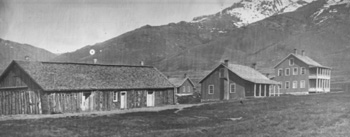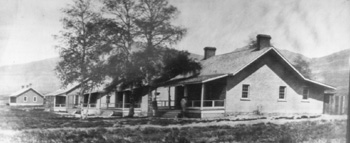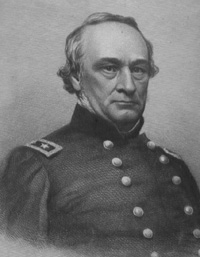He tugged out his pocket watch, held it in the moonlight and saw it was almost 2 A.M. Sighing, he knew it would be a rough day with so little sleep but, smiling to himself, he knew he had impressed all the young ladies at Widow Hay's party. The West Pointer, blond and dashing, had the world by the tail. Already, in spite of his youth, he was the fort Adjutant and Quartermaster. Suddenly the quiet morning was shattered by a volley of gunfire and bloodcurdling screams. "My God!" he said to himself, "Indians!" He grabbed for his service revolver and came up with an empty hand. He had never dreamed he would need a weapon just going to a party. It was hanging on a hook in his quarters at camp. Nothing to do but run for it. His spurs dug into the horse and the animal leaped forward, stumbled and fell, then rolled onto the officer's right leg. Not hurt, the mount scrambled to its feet with the lieutenant still holding the reins. Limping, he flung himself into the saddle urging the horse to full gallop toward camp. With his strong horse he was able to put some
distance between the screaming Indians and himself but they were still
coming. The war party chased him to within a short distance from the installation
before turning away. He galloped through the gate and yelled to the guards
to close it as he jumped from his horse and collapsed.
Two days later six companies of soldiers arrived by train and they scoured the countryside for weeks looking for hostile redskins. Eventually returning to California they had nothing to show for their noble efforts except sun-burned faces and saddle sores. Months later the truth was discovered. Each time a new commander took over Fort Halleck he reported that the facility should be closed. There really wasn't enough of a job for them to justify keeping the base open. Local residents always panicked because much of the area's economy was dependent on the military Fort. In August, 1875 it happened again. The commander was again recommending closure and this did not set well with Hamilton "Ham" McCain, who owned a hotel and bar at Halleck Station, just 12 miles north of the post. Local ranchers J.J. "Jim" Cambell and Henry "Hank" Keith joined with him. They put their heads together, fertilized their scheme with a little booze and hatched a real "doozy." They attended the same party as the young officer. When he left they followed him, armed with an assortment of weapons and whiskey. Using sagebrush for headdresses and saddle blankets for an Indian-like appearance, they opened fire (into the air, of course) while yelling blood-curdling screams. That's when the dashing lieutenant took off like a bat out of hell. Seems impossible but the episode saved the closing of the fort for a few more years by demonstrating to the Army brass that the area needed protection from warring Indians. Fort Halleck, established in 1867 to provide,
as one of its missions, security for the Central Pacific Railroad construction
project, closed in 1886. It was named for General Henry Wager Halleck,
Commander-in-Chief of the United States Army.
Troops stationed at the fort fought no battles with local peaceful Indians. Local troops traveled to northern California to help quell the Modoc uprising in 1873. Four years later cavalry troops from Halleck went to Idaho to assist in the Nez Perce uprising. Then, in 1878 they took part in the Bannock campaign in Oregon and, in 1885, lent a hand in the Apache wars in Arizona. Fort Halleck's future was doomed when General O.O. Howard wrote:
"The settlers are interested in some degree in keeping up the Post, in order to have a market near at hand for grain and other supplies they can raise. It is, considering its size, the most expensive Post in the Department." December 21, 1998
©1998 by Howard Hickson. If any portion or all of this article is used or quoted proper credit must be given to the authors. |


